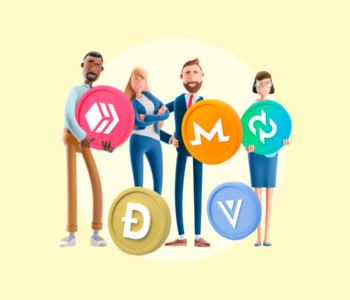 Crypto Community
Crypto Community
The Power of Crypto Communities: Building a Supportive Ecosystem
Overview of Crypto Communities
In the blockchain ecosystem, crypto communities are essential. These communities comprise many ethnic and racial groups from around the globe, passionate about particular cryptocurrencies or blockchain initiatives. Developers, financiers, users, merchants, miners, and many others are among them. Building solid and thriving communities will be even more crucial for blockchain technology’s long-term viability and widespread acceptance as the cryptocurrency field continues to grow tremendously.
Strong crypto communities encourage participation, raise awareness, offer insightful feedback to teams, and facilitate improved cooperation between various blockchain protocols. Community members frequently act as the projects’ strongest evangelists, as ambassadors to draw in new users. They also offer vital real-world validation of novel technology through testing and feedback. Ultimately, crypto communities build the groundwork for developing the entire blockchain ecosystem by actively participating.
How Crypto Communities Play a Part in Blockchain Ecosystems
The crypto community’s contributions primarily support the development of blockchain ecosystems.
- Driving adoption – Active community participation is essential for increasing acceptance of cryptocurrencies or platforms and generating awareness of new cryptocurrency projects. As evangelists, enthusiastic members explain the advantages to others, spark discussion on social media, and persuade sceptics. For expansion, this grassroots marketing is crucial.
- Giving feedback – To help blockchain companies hone and develop platforms, community members thoroughly test products, provide detailed user experiences and give critical feedback. Iterating successful products requires user feedback and real-world testing.
- Collaboration-enablement – Communities promote collaboration between various crypto projects using feedback loops, code sharing, building on top of protocols, and other methods. Technological innovation is fueled by this exchange of ideas among different cultures.
- Resource sharing – Enthusiastic community members regularly provide resources for projects such as developing tools, producing content and lessons, launching marketing campaigns, and enhancing documentation. This enhances the efforts of critical teams.
- Network security is achieved by community members actively mining or staking in some proof-of-work and proof-of-stake models to validate transactions, safeguard blockchain networks, and earn rewards.
Building a Strong Crypto Community Has Many Advantages
Building a dedicated, active community is beneficial for cryptocurrency ventures.
- Liquidity and trade volume are increased due to active communities driving demand for cryptocurrencies. This encourages sound price discovery and draws in new traders.
- Testing thoroughly validates goods by exposing them to various environments, use cases, and surface problems. Compared to internal testing, this real-world validation is quicker and frequently more efficient.
- Creating new connections – The community develops more features, tools, and connections to other protocols, increasing the usability of the project’s native blockchain or cryptocurrency.
- New user recruitment – Current community members serve as brand ambassadors, highlighting advantages and making the project more approachable to prospective new users.
- Decentralized governance – Voting on proposed changes or allocating development funding are two ways engaged token holders can participate in decentralized protocol governance.
- Access to specialized skills: Communities link projects to marketing, development, design, and other talent that core teams might lack, which is advantageous for the platform.
- Increased investment and valuation – Proactive community involvement conveys belief in the project’s potential, boosting valuation and investor trust.
Examples of Crypto Communities That Have Succeeded
Here are several initiatives that have fostered fervent communities that fuel their success:
- Ethereum – The Ethereum community is one of the biggest and busiest in the cryptocurrency world. With many knowledgeable developers creating tools and DApps that improve the protocol, it encourages inclusion and transparency. Thousands of people gather each year for the ETHGlobal hackathon.
- Uniswap – A vibrant network of liquidity providers actively supports trading pairs on the well-known decentralized exchange technology Uniswap, managed by the UNI token.
- Illuvium – A committed community of potential players and producers is already working hard to create a large, immersive gaming environment for the upcoming blockchain game Illuvium.
- CryptoKitties: An animated network of online cat merchants and collectors made the popular blockchain game CryptoKitties a significant success, demonstrating the strength of communities.
- Bitcoin – The largest communities of miners, investors, and consumers are behind Bitcoin’s growth in popularity. Content, forums, and events connect the world’s enthusiasts.
Problems with Creating and Keeping a Crypto Community
Strong communities can accelerate adoption, but some significant issues must be carefully addressed:
- Conflict resolution – Differences of opinion among community members can readily arise when decisions are made over values, course, economy, or technology. It is crucial to plan effective dispute-resolution techniques.
- Preventing toxic communities: Communities can become contaminated quickly due to online negativity, trolling, discrimination, and uncivil behaviour. Environments with proactive moderation and inclusivity are required.
- Engagement that lasts – Communities require constant encouragement, instruction, empowerment, and stimulation to stay alive, active, and intensely involved throughout time.
- Broad involvement – As interest increases rapidly, providing other voices a chance to be heard becomes more difficult. Innovative decentralized interaction mechanisms are ideal for sustaining widespread participation.
- Impact assessment: It can be challenging to monitor community health and link it to project performance measures. In addition to on-chain indications, surveys and social listening provide additional information.
An ecosystem that is supportive is what?
An environment fostering honest, positive interaction, teamwork, and development within a crypto community is called a supportive ecosystem. It offers favourable conditions for the long-term sustainability of community growth.
The Value of a Stable Ecosystem in Cryptocurrency Communities
A thriving ecology is essential for communities to realize their full potential. It is crucial for the following reasons, among others:
- Positivity and caring environments encourage members to stay involved, promoting sustained community growth.
- Increasing collaboration through information sharing and supportive cultures makes a desire to innovate as a group possible.
- Encourages community members to stick with the project for extended periods by making them feel heard, appreciated, and empowered.
- New members are attracted to welcoming and supportive groups because individuals want to participate in positive environments.
- Innovation is unlocked – Psychologically secure environments empower participants to freely exchange ideas, take chances with novel solutions, and innovate significantly.
- Talent development – Strong ecosystems give community members access to mentors, chances, and learning tools that help them develop their skills.
A Supportive Ecosystem’s Components
The following are some essential elements that should be incorporated into a crypto community architecture:
- Diversity of viewpoints and ethnicities is actively accepted in inclusive cultures. Discrimination is forbidden.
- Governance that is transparent and well-defined in terms of community responsibilities, rights, and decision-making procedures.
- Active moderation: Constructive discussions are fostered by monitoring trolls and other damaging behaviour that breaks the rules.
- Participation rewards – Token prizes, leaderboard-style recognition programs, or inventive gamification are used to encourage participation and contributions.
- Accessible communication – Sites like Reddit, Telegram, and Discord promote open dialogue and prompt feedback exchanges.
- Feedback mechanisms – Surveys, polls, and other tools constantly gather community feedback, take requests for new features and products, and pay attention to concerns.
- A wide range of learning tools are available to members to assist them in becoming more knowledgeable about cryptographic ideas and community procedures.
- Coherence in decision-making is facilitated by a shared vision and set of values that guide community actions toward similar objectives.
Building an Ecosystem that Supports Your Crypto Community
The following are some best practices to foster a robust, healthy ecosystem:
- Establish a detailed, explicit code of conduct and moderating guidelines to ensure inclusivity, good manners, and healthy discussions.
- Establish robust communication channels similar to Telegram, Discord, and Stack Overflow to facilitate open collaboration and community support.
- Token awards, recognition programs like reputation badges or leaderboards, and original individual or team quest or challenges can all be used to encourage involvement.
- You may enable decentralized government by letting the community vote on budgets, directions for development, and protocol modifications.
- To assist members in becoming knowledgeable about crypto topics, offer substantial learning tools such as tutorials, documents, videos, and webinars.
- Host physical and online gatherings like hackathons, AMAs, watch parties, and meetings to encourage interpersonal interactions and information exchange.
- Continually collect input through polls and surveys and monitor qualitative and quantitative community health indicators.
Hire local leaders from all backgrounds to be ambassadors and role models for your ideals. - Create clear means for resolving disputes, such as mediation, to handle issues when they arise positively.
How to Evaluate the Performance of Your Supportive Ecosystem
Here are some crucial indicators to monitor community health:
| Metric | Description |
|---|---|
| Community growth | Increase in engaged members over time |
| Retention rate | Proportion of members who remain active month-over-month |
| Activity levels | Frequency and volume of discussions/contributions |
| Sentiment | Positive to negative sentiment ratio in discussions |
| Conflict rate | Number of disputes/complaints reported |
| Resolution rate | How quickly conflicts get resolved |
| Contribution quality | Usefulness and impact of initiatives |
| Adoption impact | Correlation between community activity and user/revenue growth |
Additionally, surveys can offer qualitative information on the number of advocates and member satisfaction.
Conclusion
Intention, resources, and ongoing care are needed to create a thriving, encouraging community ecosystem. Still, the long-term benefits of crypto projects are immeasurable. The most effective communities foster diversity, promote participation, enable decentralized governance, and offer resources so that members may collaboratively promote mainstream acceptance. The full potential of blockchain depends on grassroots communities cooperating to influence the direction of technology, finance, and society.
FAQs
What difficulties do metrics for community health face?
Among the challenges are finding accurate automated sentiment analysis, establishing a link between metrics and commercial impact, and assessing qualitative factors like inclusion or psychological safety. Surveys are a necessary addition to quantitative data.
What are some proven methods for amicably resolving disputes in the crypto communities?
Setting up a clear code of conduct, using dispute resolution techniques like mediation, dealing with infractions quickly but fairly, and rewarding good behaviour are all ways to manage conflict productively.
What are the early warning indicators that a crypto community might deteriorate?
A community turns toxic when there are frequent heated discussions, bias against particular groups, a lack of moderation, excessive speculation or hype, verbal attacks on project leaders/teams, and a general uncivil attitude.
Why is creating a thriving crypto community so reliant on having an inclusive culture?
Innovation and diversity of viewpoints are made possible by inclusivity. Communities that practice discrimination find it challenging to persist over time, which inhibits growth. Projects need to be on the lookout for diversity from the beginning.
How might blockchain technology itself improve the ecology of the crypto communities?
Community-driven networks can be governed by decentralized using tokens, open activity records on chain, regulating incentives on chain, and identity/reputation systems.


